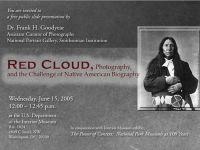Dr. Goodyear, assistant curator of photographs at the Smithsonian's National Portrait Gallery, asserts the photographic portraits of Chief Red Cloud reveal much about the sitter, the photographers, and their patrons. Red Cloud was photographed more than any other American Indian during the 19th century.
In Goodyear's book, Red Cloud: Photographs of a Lakota Chief, published in 2003 by the University of Nebraska Press, he makes the case that Red Cloud tried to overcome his Indian nation's marginalized status through the portraits. Goodyear uses this as an illustration of how native and non-native aims for the portraits were at odds in some instances, and were in accord at other times. What is clearly demonstrated is that the Chief Red Cloud's photographic portraits, taken during a 37-year period, provide unique insights into this complex American Indian leader.
Frank Goodyear studied at Princeton University as an undergraduate, and then earned his Ph.D. in American Studies from the University of Austin in 1998. In addition to serving on staff at the National Portrait Gallery, he is an affiliated faculty member at George Washington University's Department of American Studies.
The Interior Museum exhibit, "The Power of Context" gathers treasures from the National Park Service's vast collections to underscore the importance of the national park museums that preserve and interpret those artifacts for the public, including the world's first tin foil phonograph created by inventor Thomas Edison, a guitar that poet and author Carl Sandburg once owned along with a first edition copy of his American Songbag.
The exhibit will remain on display through the end of the year. The Interior Museum educates the public and Interior employees about the current missions and programs of the Interior Department, the history of the agency and the art and architecture of its headquarters building.
The museum is at 1849 C Street, N.W., just a block off the National Mall and a few minutes walk from The White House. It is open weekdays except holidays from 8:30 a.m. to 4:30 p.m. and from 1:00 p.m. to 4:00 p.m. the third Saturday of each month. Admission is free; adult visitors must present a form of photo identification (such as a driver's license, student ID, or employment card) when entering the building. Wheelchair access is available at the 18th and E Streets entrance. More information is available by calling (202) 208-4743 or by visiting the museum's Web site at doi.gov/interiormuseum. SOURCE: -DOI-
Office of the Secretary Contact: Anne James, June 1, 2005 202-208-4659, Interior Museum Lecture Spotlights, Oglala Chief Red Cloud









